Dallas–Fort Worth metroplex
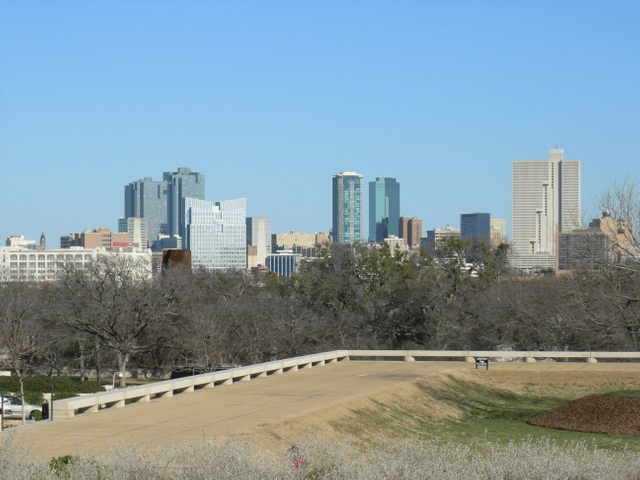
Dallas–Fort Worth metroplex

Dallas–Fort Worth–Arlington | |
|---|---|
Conurbation | |
 Downtown Dallas, Texas, in 2012 | |
 AT&T Stadium in Arlington | |
| Country | United States |
| State | Texas |
| Principal cities |
|
| Area | |
| • Urban | 1,407.0 sq mi (3,644.2 km2) |
| • Metro | 9,286 sq mi (24,059 km2) |
| Highest elevation | 1,368 ft (417 m) |
| Population | |
| • Density | 634/sq mi (245/km2) |
| • Urban | 5,121,892 (6th) |
| • MSA | 6,366,542 (4th) |
| • CSA | 6,807,747 (7th) |
| MSA/CSA/Urban: 2010 | |
| Time zone | UTC-6 (CST) |
| • Summer (DST) | UTC-5 (CDT) |
| Area code(s) | 214, 254, 469, 682, 817, 903, 940, 972 |
| Interstates | |
The Dallas–Fort Worth metroplex, officially designated the Dallas–Fort Worth–Arlington, TX Metropolitan Statistical Area by the U.S. Office of Management and Budget,[3] is a metropolitan area in the U.S. state of Texas encompassing 13 counties. It is the economic and cultural hub of North Texas. Residents of the area also refer to it as DFW, or the Metroplex.
The Dallas–Fort Worth metroplex's population is 7,539,711 according to the U.S. Census Bureau's 2018 population estimates,[4] making it the most populous metropolitan area in both Texas and the South, the fourth-largest in the U.S., and the tenth-largest in the Americas. In 2016, Dallas–Fort Worth ascended to the number one spot in the nation in year-over-year population growth.[5]
The region's economy is primarily based on banking, commerce, telecommunications, technology, energy, healthcare and medical research, and transportation and logistics. In 2019, Dallas–Fort Worth is home to 25[6] Fortune 500 companies,[7][8] the third-largest concentration of Fortune 500 companies in the United States behind New York City (70) and Chicago (34).[9] In 2016, the metropolitan economy surpassed Houston to become the fourth-largest in the nation. Currently the region boasts a GDP of just over $613.4 billion in 2019.[10] As such, the metropolitan area's economy is ranked the 10th largest in the world. The DFW metroplex encompasses 9,286 square miles (24,100 km2) of total area: 8,991 sq mi (23,290 km2) is land, while 295 sq mi (760 km2) is water, making it larger in area than the states of Rhode Island and Connecticut combined.
Dallas–Fort Worth–Arlington | |
|---|---|
Conurbation | |
 Downtown Dallas, Texas, in 2012 | |
 AT&T Stadium in Arlington | |
| Country | United States |
| State | Texas |
| Principal cities |
|
| Area | |
| • Urban | 1,407.0 sq mi (3,644.2 km2) |
| • Metro | 9,286 sq mi (24,059 km2) |
| Highest elevation | 1,368 ft (417 m) |
| Population | |
| • Density | 634/sq mi (245/km2) |
| • Urban | 5,121,892 (6th) |
| • MSA | 6,366,542 (4th) |
| • CSA | 6,807,747 (7th) |
| MSA/CSA/Urban: 2010 | |
| Time zone | UTC-6 (CST) |
| • Summer (DST) | UTC-5 (CDT) |
| Area code(s) | 214, 254, 469, 682, 817, 903, 940, 972 |
| Interstates | |
Origin of the term
A portmanteau of metropolis and complex, the term metroplex is credited to Harve Chapman, an executive vice president with Dallas-based Tracy-Locke which was one of three advertising agencies that worked with the North Texas Commission (NTC) on strategies to market the region.[11] The NTC copyrighted[12] the term "Southwest Metroplex" in 1972 as a replacement for the previously-ubiquitous "North Texas", which studies had shown lacked identifiability outside the state. In fact, only 38 percent of a survey group identified Dallas and Fort Worth as part of "North Texas", with the Texas Panhandle also a perceived correct answer, being the northernmost region of Texas.[13]
Metroplex counties
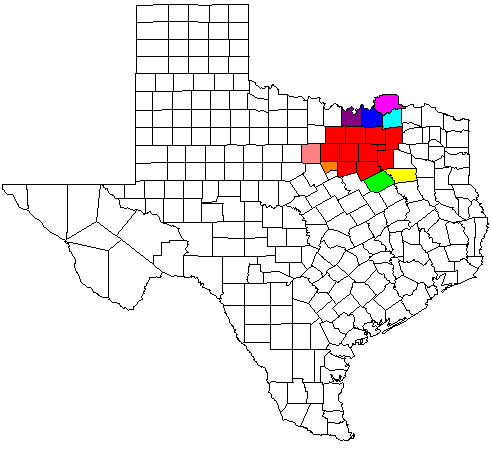
Counties in the Dallas–Fort Worth, TX–OK Combined Statistical Area[15] Dallas–Fort Worth–Arlington, TX MSA Sherman-Denison, TX MSA Athens, TX μSA Granbury, TX μSA Corsicana, TX μSA Durant, OK μSA Gainesville, TX μSA Bonham, TX μSA Mineral Wells, TX μSA
The Dallas–Fort Worth Metroplex is formed by a combination of two separate metropolitan divisions. The Dallas–Plano–Irving MDA and Fort Worth–Arlington-Grapevine MDA come together to form one full metropolitan area.[14]
Dallas–Plano–Irving Metropolitan Division[15]
Collin County
Dallas County
Denton County
Ellis County
Hunt County
Kaufman County
Rockwall County
Fort Worth–Arlington-Grapevine Metropolitan Division[15]
Johnson County
Parker County
Tarrant County
Wise County
Metroplex cities, towns, and CDPs
Note: Cities and towns are categorized based on the latest population estimates from the North Central Texas Council of Governments (as of January 1, 2018).[16] No population estimates are released for census-designated places (CDPs), which are marked with an asterisk (*). These places are categorized based on their 2010 census population.[17]
Places with more than 100,000 inhabitants
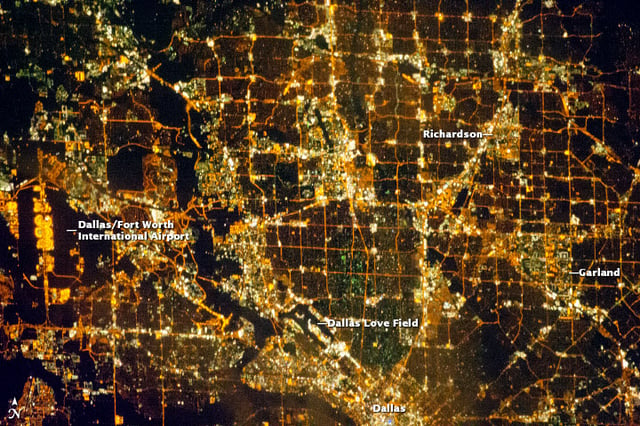
Northern Dallas metropolitan area at night – astronaut photo, courtesy NASA (November 15, 2012)
Places designated "principal cities" by the Office of Management and Budget (OMB) are italicized.[18]
1,000,000+
Dallas (1,286,380)
500,000–999,999
Fort Worth (829,560)
200,000–499,999
Arlington (383,950)
Plano (281,390)
Irving (237,490)
Garland (236,030)
100,000–199,999
Grand Prairie (189,430)
McKinney (179,970)
Frisco (172,940)
Mesquite (143,350)
Carrollton (132,330)
Denton (130,990)
Richardson (110,140)
Lewisville (104,780)
Places with 10,000 to 99,999 inhabitants
Addison
Allen
Anna
Azle
Balch Springs
Bedford
Benbrook
Burleson
Cedar Hill
Celina
Cleburne
Colleyville
Coppell
Corinth
Crowley
DeSoto
Duncanville
Ennis
Euless
Farmers Branch
Fate
Flower Mound
Forest Hill
Forney
Glenn Heights
Grapevine
Greenville
Haltom City
Highland Village
Hurst
Keller
Lancaster
Little Elm
Mansfield
Midlothian
Mineral Wells (partial)
Murphy
North Richland Hills
Prosper
Red Oak
Rockwall
Rowlett
Royse City
Sachse
Saginaw
Seagoville
Southlake
Terrell
The Colony
Trophy Club
University Park
Watauga
Waxahachie
Weatherford
White Settlement
Wylie
Places with fewer than 10,000 inhabitants
Aledo
Alma
Alvarado
Alvord
Annetta North
Annetta South
Annetta
Argyle
Aubrey
Aurora
Bardwell
Bartonville
Blue Mound
Blue Ridge
Boyd
Briar*
Briaroaks
Bridgeport
Caddo Mills
Campbell
Celeste
Chico
Cockrell Hill
Combine
Commerce
Cool
Cooper
Copper Canyon
Corral City
Cottonwood
Crandall
Cresson (partial)
Cross Roads
Cross Timber
Dalworthington Gardens
Decatur
DeCordova
Dennis
DISH
Double Oak
Eagle Mountain*
Edgecliff Village
Everman
Fairview
Farmersville
Ferris
Garrett
Glen Rose
Godley
Granbury
Grandview
Grays Prairie
Gun Barrel City
Hackberry
Haslet
Hawk Cove
Heath
Hebron
Hickory Creek
Highland Park
Hudson Oaks
Hutchins
Italy
Josephine
Joshua
Justin
Kaufman
Keene
Kemp
Kennedale
Knollwood
Krugerville
Krum
Lake Bridgeport
Lake Dallas
Lake Worth
Lakeside
Lakewood Village
Lavon
Leonard
Lincoln Park
Lone Oak
Lowry Crossing
Lucas
Mabank (partial)
Maypearl
McLendon-Chisholm
Melissa
Milford
Millsap
Mobile City
Nevada
New Fairview
New Hope
Newark
Neylandville
Northlake
Oak Grove
Oak Leaf
Oak Point
Oak Ridge
Ovilla
Palmer
Pantego
Paradise
Parker
Pecan Acres*
Pecan Hill
Pelican Bay
Pilot Point
Ponder
Post Oak Bend City
Princeton
Providence Village
Quinlan
Rendon*
Reno
Rhome
Richland Hills
Rio Vista
River Oaks
Roanoke
Rosser
Runaway Bay
Saint Paul
Sanctuary
Sanger
Sansom Park
Scurry
Shady Shores
Springtown
Sunnyvale
Talty
Union Valley
Van Alstyne (partial)
Venus
West Tawakoni
Westlake
Weston
Westover Hills
Westworth Village
Willow Park
Wilmer
Wolfe City
Unincorporated places
Ables Springs
Acton
Avalon
Bolivar
Brock
Cash
Copeville
Elizabethtown
Elmo
Floyd
Forreston
Garner
Greenwood
Heartland
Ike
Lantana
Lillian
Merit
Paloma Creek
Peaster
Poetry
Poolville
Rockett
Sand Branch
Savannah
Slidell
Telico
Westminster
Whitt
Trumbull
Demographics
As of the 2010 United States census,[19] there were 6,371,773 people. The racial makeup of the MSA was 50.2% White, 15.4% African American, 0.6% Native American, 5.9% Asian, 0.1% Pacific Islander, 10.0% from other races, and 2.4% from two or more races. Hispanic or Latino of any race were 27.5% of the population.
The median income for a household in the MSA was $48,062, and the median income for a family was $55,263. Males had a median income of $39,581 versus $27,446 for females. The per capita income for the MSA was $21,839.
| County | 2017 Estimate | 2010 Census | Change | Area | Density |
|---|---|---|---|---|---|
| Collin County | 969,603 | 782,341 | +23.94% | 841.22 sq mi (2,178.7 km2) | 1,153/sq mi (445/km2) |
| Dallas County | 2,618,148 | 2,368,139 | +10.56% | 871.28 sq mi (2,256.6 km2) | 3,005/sq mi (1,160/km2) |
| Denton County | 836,210 | 662,614 | +26.20% | 878.43 sq mi (2,275.1 km2) | 952/sq mi (368/km2) |
| Ellis County | 173,620 | 149,610 | +16.05% | 935.49 sq mi (2,422.9 km2) | 186/sq mi (72/km2) |
| Hood County | 58,273 | 51,182 | +13.85% | 420.64 sq mi (1,089.5 km2) | 139/sq mi (53/km2) |
| Hunt County | 93,872 | 86,129 | +8.99% | 840.32 sq mi (2,176.4 km2) | 112/sq mi (43/km2) |
| Johnson County | 167,301 | 150,934 | +10.84% | 724.69 sq mi (1,876.9 km2) | 231/sq mi (89/km2) |
| Kaufman County | 122,883 | 103,350 | +18.90% | 780.70 sq mi (2,022.0 km2) | 157/sq mi (61/km2) |
| Parker County | 133,463 | 116,927 | +14.14% | 903.48 sq mi (2,340.0 km2) | 148/sq mi (57/km2) |
| Rockwall County | 96,788 | 78,337 | +23.55% | 127.04 sq mi (329.0 km2) | 762/sq mi (294/km2) |
| Somervell County | 8,845 | 8,490 | +4.18% | 186.46 sq mi (482.9 km2) | 47/sq mi (18/km2) |
| Tarrant County | 2,054,475 | 1,809,034 | +13.57% | 863.61 sq mi (2,236.7 km2) | 2,379/sq mi (919/km2) |
| Wise County | 66,181 | 59,127 | +11.93% | 904.42 sq mi (2,342.4 km2) | 73/sq mi (28/km2) |
| Total | 7,399,662 | 6,426,214 | +15.15% | 9,277.78 sq mi (24,029.3 km2) | 798/sq mi (308/km2) |
Combined Statistical Area
The Dallas–Fort Worth, TX–OK Combined Statistical Area is made up of 20 counties in north central Texas and one county in southern Oklahoma. The statistical area includes two metropolitan areas and seven micropolitan areas. As of the 2010 Census, the CSA had a population of 6,817,483 (though a July 1, 2015 estimate placed the population at 7,504,362).[20] The CSA definition encompasses 14,628 sq mi (37,890 km2) of area, of which 14,126 sq mi (36,590 km2) is land and 502 sq mi (1,300 km2) is water.
Components
Metropolitan Statistical Areas (MSAs)
Dallas–Fort Worth–Arlington (Collin, Dallas, Denton, Ellis, Hunt, Johnson, Kaufman, Parker, Rockwall, Tarrant, and Wise counties)
Sherman-Denison (Grayson County)
Micropolitan Statistical Areas (μSAs)
Athens (Henderson County)
Bonham (Fannin County) (delineated and added in 2015)
Corsicana (Navarro County)
Durant, OK (Bryan County, Oklahoma)
Gainesville (Cooke County)
Granbury (Hood County) (delineated and added in 2018)
Mineral Wells (Palo Pinto County)
Demographics
As of the census[19] of 2000, there were 5,487,956 people, 2,006,665 households, and 1,392,540 families residing within the CSA. The racial makeup of the CSA was 70.41% White, 13.34% African American, 0.59% Native American, 3.58% Asian, 0.08% Pacific Islander, 9.62% from other races, and 2.39% from two or more races. Hispanic or Latino of any race were 20.83% of the population. It is home to the fourth-largest Muslim population in the country.
The median income for a household in the CSA was $43,836, and the median income for a family was $50,898. Males had a median income of $37,002 versus $25,553 for females. The per capita income for the CSA was $20,460.
Geography
The metroplex overlooks mostly prairie land with a few rolling hills dotted by man-made lakes cut by streams, creeks and rivers surrounded by forest land. The metroplex is situated in the Texas blackland prairies region, so named for its fertile black soil found especially in the rural areas of Collin, Dallas, Ellis, Hunt, Kaufman, and Rockwall counties.
Many areas of Denton, Johnson, Parker, Tarrant, and Wise counties are located in the Fort Worth Prairie[21] region of North Texas, which has less fertile and more rocky soil than that of the Texas blackland prairie; most of the rural land on the Fort Worth Prairie is ranch land. A large onshore natural gas field, the Barnett Shale, lies underneath this area; Denton, Tarrant and Wise counties feature many natural gas wells. Continuing land use change results in scattered crop fields surrounded by residential or commercial development.
South of Dallas and Fort Worth is a line of rugged hills that goes north to south about 15 miles (24 km) that looks similar to the Texas Hill Country 200 miles (320 km) to the south.
Economy
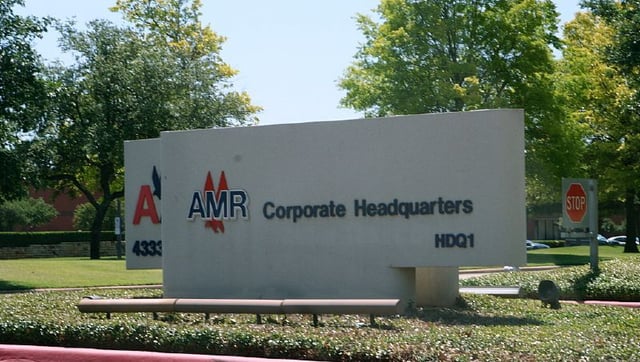
Headquarters of AMR Corporation and American Airlines
The cities of Dallas and Fort Worth are the two central cities of the metroplex, with Arlington being a third economically important city; it is a center for sporting events, tourism and manufacturing. Most other incorporated cities in the metroplex are "bedroom communities" serving largely as residential and small-business centers, though there are several key employers in these regions. Due to the large number of smaller, less well-known cities, metroplex residents commonly divide the region roughly in half along Texas Interstate 35, which runs north-south, splitting into two 'branches' (I-35E in Dallas and I-35W in Fort Worth) through the metroplex. They refer to places as being on the "Dallas side" or the "Fort Worth side", or in "the Arlington area", which is almost directly south of the airport. It is nominally between the two major east-west interstates in the region (I-20, passing to the south of both downtowns, and I-30, connecting Dallas and Fort Worth city centers).
Dallas and its suburbs have one of the highest concentrations of corporate headquarters in the United States. Business management and operations is a major part of the economy. The metroplex also contains the largest Information Technology industry base in the state (often referred to as Silicon Prairie or the Telecom Corridor, especially when referring to US-75 through Richardson, Plano and Allen just north of Dallas itself). This area has a large number of corporate IT projects and the presence of numerous electronics, computing and telecommunication firms such as Microsoft, Texas Instruments, HP Enterprise Services, Dell Services, Samsung, Nokia, Cisco, Fujitsu, i2, AT&T, Frontier, Alcatel-Lucent, Ericsson, CA, Google, and Verizon in and around Dallas. On the other end of the business spectrum, and on the other side of the metroplex, the Texas farming and ranching industry is based in Fort Worth. According to the Dallas Business Journal 's 2006 Book of Lists, American Airlines is the largest employer in the metroplex. Several major defense manufacturers, including Lockheed Martin, Bell Helicopter Textron, and Raytheon, maintain significant operations in the metroplex, primarily on the "Fort Worth side." They are concentrated along State Highway 170 near I-35W, commonly called the "Alliance Corridor" due to its proximity to the Fort Worth Alliance regional airport. ExxonMobil, the #2 corporation on the Fortune 500 listings, is headquartered in Irving, Texas. Toyota USA, in 2016, relocated its corporate headquarters to Plano, Texas. Southwest Airlines hold their headquarters in Dallas. The airline has more than 53,000 employees as of October 2016 and operates more than 3,900 departures a day during peak travel season. In October 2016, Jacobs Engineering, a Fortune 500 company and one of the world’s largest engineering companies, relocated from Pasadena, California to Dallas.[22]
Changes in house prices for the metroplex are publicly tracked on a regular basis using the Case–Shiller index; the statistic is published by Standard & Poor's and is also a component of S&P's 20-city composite index of the value of the U.S. residential real estate market.
Higher education
Notable colleges and universities
| School | Enrollment | Location | Mascot | Athletic Affiliation (Conference) | University System |
|---|---|---|---|---|---|
 University of Texas at Arlington | 42,496 | Arlington | Mavericks | NCAA Division I (Sun Belt) Non–Football | University of Texas System |
 University of North Texas | 37,979 | Denton | Mean Green | NCAA Division I FBS (C–USA) | University of North Texas System |
 University of Texas at Dallas | 26,793 | Richardson | Comets | NCAA Division III (American Southwest) Non–Football | University of Texas System |
 Texas Woman's University | 15,472 | Denton | Pioneers | NCAA Division II (Lone Star) Women's sports only | Independent |
 Texas A&M University–Commerce | 12,385 | Commerce | Lions | NCAA Division II (Lone Star) | Texas A&M University System |
 University of North Texas at Dallas | 3,030 | Dallas | Trailblazers | No Athletics (N/A) | University of North Texas System |
| School | Enrollment | Location | Mascot | Athletic Affiliation (Conference) |
|---|---|---|---|---|
 Southern Methodist University | 11,643 | University Park | Mustangs | NCAA Division I FBS (American) |
 Texas Christian University | 10,394 | Fort Worth | Horned Frogs | NCAA Division I FBS (Big 12) |
 Dallas Baptist University | 5,445 | Dallas | Patriots | NCAA Division II (Lone Star) Non–Football, compete in the Missouri Valley Conference at the Division I level for baseball |
 Texas Wesleyan University | 3,378 | Fort Worth | Rams | NAIA (Sooner) |
 University of Dallas | 2,387 | Irving | Crusaders [39] | NCAA Division III (SCAC) Non–Football, compete in Texas Rugby Union at the Division II level for Rugby |
 Southwestern Assemblies of God University | 2,012 | Waxahachie | Lions | NAIA NCCAA (Sooner and Central States Football League) |
 Paul Quinn College | 600 | Dallas | Tigers | NAIA (Red River) Non–Football |
Politics
| Year | Republican | Democratic |
|---|---|---|
| 2016 | 53% 1,217,018 | 46% 1,062,196 |
| 2012 | 57% 1,202,585 | 43% 896,612 |
| 2008 | 55% 1,190,150 | 45% 970,130 |
| 2004 | 62% 1,190,362 | 38% 732,787 |
| 2000 | 62% 973,070 | 38% 587,889 |
Since the late 20th century and the realignment of party affiliations, white conservatives have shifted to the Republican Party, and its national candidates have won in the Dallas–Fort Worth area, including in presidential elections. Democratic voters dominate a majority of areas in the large cities of Dallas, Fort Worth, Grand Prairie, and Arlington (especially areas east of Interstate 35W).[23][24] Republicans dominate North Dallas, western Fort Worth and the rest of Tarrant County, most suburbs, and the rural areas of the metroplex.
Transportation
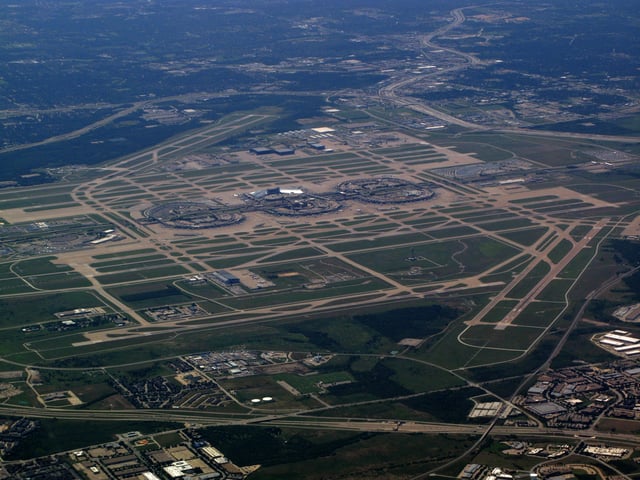
Dallas/Fort Worth International Airport

DFW freeway map
The Dallas/Fort Worth International Airport (IATA airport code: DFW), located between the cities of Dallas and Fort Worth, is the largest and busiest airport in the state of Texas. At 17,207 acres (6,963 ha) of total land area, DFW is also the second-largest airport in the country and the sixth-largest in the world. It is the third-busiest airport in the world in terms of aircraft movements and the world's seventh-busiest by passenger traffic, transporting 62.9 million passengers in FY 2014.[25] Based in Fort Worth, American Airlines' headquarters are adjacent to DFW. Recently having regained the title as the largest airline in the world in terms of both passengers transported and fleet size, American is a predominant leader in domestic routes and operations.[26]
Love Field Airport (IATA airport code: DAL) is located in northwest Dallas. Based in Dallas, Southwest Airlines is headquartered next to Love Field.
The Dallas–Fort Worth area has thousands of lane-miles of freeways and interstates. The metroplex has the second-largest number of freeway-miles per capita in the nation, behind only the Kansas City Metropolitan Area. As in most major metropolitan areas in Texas, most interstates and freeways have access or frontage roads where most of the businesses are located; these access roads have slip ramps allowing traffic to transition between the freeway and access road. North-south interstates include I-35 and I-45. East-west routes include I-30 and I-20. I-35 splits into I-35E and I-35W from Denton to Hillsboro: I-35W goes through Fort Worth while I-35E goes through Dallas. (This is one of only two examples of an interstate splitting off into branches and then rejoining as one; the other such split is in Minneapolis-St. Paul where I-35E goes into St. Paul and I-35W goes through Minneapolis.) I-30 connects Dallas and Fort Worth, and I-45 connects Dallas to Houston. The "multiple-of-5" numbers used for the interstate designations are notable, as these numbers were designed to be used for major multi-state arteries of the U.S. Interstate Highway System. The North Texas region is the terminus for two of them, and I-45 is located only within Texas.
HOV lanes exist along I-35E, I-30, I-635, US 67, and US 75. I-20 bypasses both Dallas and Fort Worth to the south while its loop, I-820, goes around Fort Worth. I-635 splits to the north of I-20 and loops around east and north Dallas, ending at SH 121 north of DFW Airport. I-35E, Loop 12, and Spur 408 ultimately connect to I-20 southwest of Dallas, completing the west bypass loop around Dallas. A large number of construction projects are planned or are already underway in the region to alleviate congestion. Due largely to funding issues, many of the new projects involve building new tollways or adding tolled express lanes to existing highways, which are managed by the North Texas Tollway Authority. It was originally established to manage the Dallas North Tollway and oversees several other toll projects in the area.
Public transit
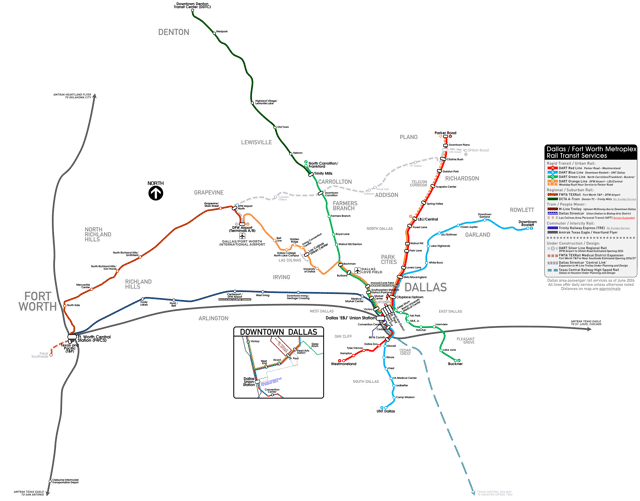
Map of rail public rail transit in the Dallas–Fort Worth area
Public transit options continue to expand significantly throughout the metroplex. However, it is limited in several outlying and rural suburbs. Dallas County and portions of Collin and Rockwall counties have bus service and light rail operated by Dallas Area Rapid Transit (DART), covering thirteen member cities. DART's rail network currently sprawls for 93 miles throughout the area. The Red Line extends north to Plano and southwest to Westmoreland Road. The Blue Line reaches from Rowlett in the northeast to the University of North Texas at Dallas campus near I-20 in the south. The 28-mile Green Line, which opened in December 2010, connects Carrollton in the northwest through Downtown Dallas to Pleasant Grove in the southeast. The Orange Line, which completed expansion in 2014, parallels the Red Line from Plano to Downtown Dallas and the Green Line from Downtown Dallas to Northwest Hwy before extending through the Las Colinas area of Irving to reach DFW International Airport.
Denton County has bus service limited to Denton, Highland Village, and Lewisville (with commuter service to downtown Dallas) provided by the Denton County Transportation Authority (DCTA). The A-train, a diesel commuter rail line, parallels I-35E to connect Denton, Highland Village, Lewisville, and Carrollton. Several smaller towns along this line, Corinth, Shady Shores, and Lake Dallas, voted to abstain from DCTA and do not have stations. There is an across-the-platform transfer in Carrollton to the DART Green Line. A-Train service began June 20, 2011.[27]
Tarrant County has bus services operated by Trinity Metro (formerly the Fort Worth Transportation Authority, popularly known as 'The T'), available only in Fort Worth. It additionally operates TEXRail commuter rail, which serves to connect downtown Fort Worth with DFW Airport and the DART Orange Line. The diesel commuter train that serves Fort Worth and its eastern suburbs is operated as the Trinity Railway Express; it connects downtown Fort Worth to downtown Dallas, where it links to the DART light rail system. A station near its midpoint, Centerport, also serves DFW Airport via a free airport shuttle bus. The TRE is jointly owned by FWTA and DART.[28] Amtrak serves two stations in the Metroplex - Dallas Union Station and Fort Worth Central Station. Both are served by the Texas Eagle route, which operates daily between Chicago and San Antonio (continuing on to Los Angeles three days a week), though only the latter station is served by the Fort Worth-Oklahoma City Heartland Flyer.
As of 2016 the Taiwanese airline EVA Air operates a shuttle bus service from George Bush Intercontinental Airport in Houston to Richardson, so that Dallas-based customers may fly on its services to and from Houston.[29]
Largest area employers
Dallas–Fort Worth metroplex[30]
| Company | No. of employees locally | Type of business |
|---|---|---|
| Wal-Mart Stores, Inc. | 34,000 | Retail |
| American Airlines | 27,000 | Commercial airline |
| Texas Health Resources | 22,296 | Health care |
| Dallas Independent School District | 19,740 | Education |
| Baylor Health Care System | 16,500 | Health care |
Media
The cities of Dallas and Fort Worth have their own newspapers, The Dallas Morning News and the Fort Worth Star-Telegram, respectively. Historically, the two papers had readership primarily in their own counties. As the two cities' suburbs have grown together in recent years (and especially since the demise of the Dallas Times Herald in 1991), many sites sell both papers. This pattern of crossover has been repeated in other print media, radio, and television. Since the 1970s all of the television stations and most of the FM radio stations have chosen to transmit from Cedar Hill so as to serve the entire market, and are programmed likewise. There has been a rise in "80–90 move-ins", whereby stations have been moved from distant markets, in some cases as far away as Oklahoma, and relicensed to anonymous small towns in the metroplex to serve as additional DFW stations. According to RadioTime, the market has 38 AM stations, 58 FM stations (many of them class Cs), and 18 full-power television stations. Dallas–Fort Worth is the fifth-largest television market in the United States, behind only New York City, Los Angeles, Chicago, and Philadelphia.
Two metroplex AM radio stations, 820 WBAP and 1080 KRLD, are 50,000-watt stations with coverage of much of the North American continent and beyond during nighttime hours.
The South Asian population (Indian Sub-continent) has increased considerably in the DFW metroplex. They have the FM 104.9 radio channel and 700 AM radio.[31] Recently Sony TV, a subsidiary of Sony TV Asia, launched its FTA (free to Air OTA) channel on 44.2 station in DFW. It was one of the two locations they chose in USA; the other being NYC, where there is also a large South Asian demographic.
TV stations
The following are full-powered stations serving the Dallas–Fort Worth television market. Network owned-and-operated stations are highlighted in bold.
| Channel | Call Sign (branding) | Primary Network Affiliation | Subchannel(s) | City of License | Owner |
|---|---|---|---|---|---|
| 2.1 | KDTN | Daystar | None | Denton, TX | Word of God Fellowship (Community Television Educators of DFW, Inc.) |
| 4.1 | KDFW (Fox 4) | Fox | None | Dallas | Fox Television Stations (NW Communications of Texas, Inc.) |
| 5.1 | KXAS-TV (NBC 5) | NBC | 5.2 Cozi TV | Fort Worth | NBCUniversal Owned Television Stations (Station Venture Operations, LP) |
| 8.1 | WFAA (WFAA-TV Channel 8) | ABC | 8.2 AccuWx 8.3 Justice Network8.4 Quest | Dallas | Tegna Media (WFAA-TV, Inc.) |
| 11.1 | KTVT (CBS 11) | CBS | 11.2 Decades | Fort Worth | CBS Corporation (CBS Stations Group of Texas, Inc.) |
| 13.1 | KERA-TV (KERA) | PBS | 13.2 KERA Kids 13.3 Create | Dallas | North Texas Public Broadcasting |
| 18.1 | KPFW-LD | Hope Channel broadcasting | None | Dallas | Iglesia JesuCristo es mi Refugion, Inc. (Sale to DTV America Corporation pending) |
| 20.1 | KBOP-LD | Infomercial | 20.2 Infomercial 20.3 3ABN (Spanish) 20.4 3ABN | Dallas | Randolph W. Weigner (D.T.V., LLC.) |
| 21.1 | KTXA (TXA 21) | Independent | 21.2 MeTV | Fort Worth | CBS Corporation (Television Station KTXA Inc.) |
| 22 | KNAV-LP | Hot TV Network | None (low-power analog) | DeSoto, TX | Tuck Properties |
| 23.1 | KUVN-DT (Univision 23) | Univision | 23.2 Bounce TV 23.3 Escape 23.4 LAFF | Garland, TX | Univision Communications (KUVN License Partnership, LP) |
| 25.1 | K25FW-D | HSN | None | Corsicana, TX | Ventana Television, Inc. |
| 26.1 | KODF-LD (KODF-TV) | Guide US TV | 26.2 Soul of the South TV 26.3 Almavision 26.4 HSN2 | Britton, TX | Mako Communications, LLC |
| 27.1 | KDFI (My27) | MyNetworkTV | 27.2 Movies! 27.3 Buzzr 27.4 Heroes and Icons 27.5 Light TV | Dallas | Fox Television Stations (NW Communications of Texas, Inc.) |
| 28.1 | KHPK-LD | SonLife | 28.2 Guide US TV 28.3 Shop LC 28.4 Soul of the South TV | DeSoto, TX | Mako Communications, LLC |
| 29.1 | KMPX (Estrella TV KMPX 29) | Estrella TV | 29.2 Inmigrante TV | Decatur, TX | Liberman Broadcasting (Liberman Television of Dallas License LLC) |
| 31.1 | K31GL-D | SonLife | 31.2 Hot TV Network 31.3 Hot TV Network 31.4 RTV | DeSoto, TX | Mako Communications, LLC |
| 33.1 | KDAF (CW33) | The CW | 33.2 Antenna TV 33.3 This TV33.4 Charge | Dallas | Tribune Broadcasting (Sale to Sinclair Broadcast Group pending) (KDAF, LLC) |
| 34.1 | KJJM-LD (Access 34) | HSN | 34.2 Shop LC 34.3 HSN2 34.4 Jewelry TV 34.5 Infomercial | Dallas & Mesquite, TX | Mako Communications, LLC |
| 38.1 | KVFW-LD (KVFW 38) | Infomercial | 38.3 RTN 38.4 Rev'n | Fort Worth | CMMB America (New York Spectrum Holding Company, LLC) |
| 39.1 | KXTX-TV (Telemundo 39) | Telemundo | 39.2 TeleXitos | Dallas | NBCUniversal (NBC Telemundo License LLC) |
| 44.1 | KLEG-CD (Vmas) | TVC+Latino [40] | 44.3 Diya TV - America's first South Asian broadcast television network 44.4 SAB TV (Indian) | Dallas | Dilip Viswanath |
| 46.1 | KUVN-CD (Univision 23) | Univision | None (mirror broadcast of KUVN-DT) | Garland, TX | Univision Communications (KUVN License Partnership, LP) |
| 47.1 | KTXD-TV (Texas 47) | Independent | 47.2 Comet 47.3 Charge 47.4 TBD 47.5 SonLife | Greenville, TX | London Broadcasting Company (KTXD License Company, LLC) |
| 49.1 | KSTR-DT (UniMás 49) | UniMás | 49.2 GetTV 49.3 Grit | Irving, TX | Univision Communications (UniMas Dallas, LLC) |
| 51.1 | KHFD-LD | The Walk TV | 51.2 Cornerstone Television 51.4 Global Christian Network | Cedar Hill, TX | Randall & Adrienne Weiss (EICB-TV West LLC) |
| 52.1 | KFWD | SonLife | 52.3 QVC Plus 52.4 Evine | Fort Worth | NRJ Holdings LLC (NRJ TV DFW License Co, LLC) |
| 55.1 | KAZD (Azteca 55) | Azteca América | 55.2 MBC America (Korean) 55.3 SBTN (Vietnamese) 55.4 QVC 55.5 VietFace TV (Vietnamese) 55.6 Biz Television 55.7 Spanish-language infomercials | Lake Dallas, TX | Northstar Media, LLC (Northstar Dallas License, LLC) |
| 58.1 | KDTX-TV | TBN | 58.2 Hillsong Channel 58.3 JUCE TV 58.4 Enlace 58.5 Smile | Dallas | Trinity Broadcasting Network (Trinity Broadcasting of Texas, Inc.) |
| 68.1 | KPXD-TV (Ion Television) | Ion Television | 68.2 qubo 68.3 Ion Life 68.4 Ion Shop68.5 QVC 68.6 HSN | Arlington, TX | Ion Media Networks (Ion Media Dallas License, Inc.) |
Radio stations
Category:Radio stations in the Dallas–Fort Worth metroplex
Sports
The metroplex is one of the 13 American metropolitan areas that has a team in each of the four major professional sports leagues. Major professional sports first came to the area in 1952, when the Dallas Texans competed in the National Football League for one season. In 1960, major professional sports returned when The Dallas Cowboys began competing in the National Football League and the Dallas Texans began competing in the American Football League. (The Texans later relocated to Kansas City and became the Chiefs). In 1972, Major League Baseball's Washington Senators moved to Arlington to become the Texas Rangers, named after the statewide law enforcement agency. The National Basketball Association expanded into North Texas in 1980 when the Dallas Mavericks were added to the league. The fourth sport was added in 1993 when the Minnesota North Stars of the National Hockey League moved to Dallas, becoming the Dallas Stars.
The Major League Soccer team FC Dallas is based in Frisco, and the Dallas Wings of the WNBA play in Arlington. The area is also home to many minor-league professional teams, and four colleges that compete in NCAA Division I athletics. Two Monster Energy NASCAR Cup Series races are hosted annually at Texas Motor Speedway, the Duck Commander 500 and the AAA Texas 500. The metroplex has hosted many premiere sports events on both an annual and one-time basis.
Major professional sports teams
| Club | Sport | Founded | League | Venue |
|---|---|---|---|---|
 Dallas Cowboys | Football | 1960 | NFL | AT&T Stadium |
 Texas Rangers | Baseball | 1972^ | MLB | Globe Life Park in Arlington |
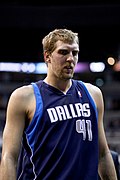 Dallas Mavericks | Basketball | 1980 | NBA | American Airlines Center |
 Dallas Stars | Hockey | 1993^ | NHL | American Airlines Center |
 FC Dallas | Soccer | 1996 | MLS | Toyota Stadium |
 Dallas Wings | Basketball | 2015^ | WNBA | College Park Center |
| Dallas Rattlers | Lacrosse | 2018^ | MLL | The Ford Center at The Star |
^- Indicates year team relocated to the area
Other notable professional and amateur teams
| Club | Sport | Founded | League | Venue |
|---|---|---|---|---|
| Allen Americans | Ice hockey | 2009 | ECHL | Allen Event Center |
| Lone Star Brahmas | Ice hockey | 1999 | NAHL | NYTEX Sports Centre |
| Mid-Cities Junior Stars | Ice hockey | 2013 | NA3HL | Dr. Pepper StarCenter |
| Texas Jr. Brahmas | Ice hockey | 2014 | NA3HL | NYTEX Sports Centre |
| Dallas Snipers | Ice hockey | 2011 | Western States Hockey League | Dr. Pepper StarCenter |
| Dallas Sidekicks | Indoor soccer | 2012 | Major Arena Soccer League | Allen Event Center |
| Frisco RoughRiders | Baseball | 2003^ | Texas League | Dr Pepper Ballpark |
| Cleburne Railroaders | Baseball | 2017 | AAIPBL | The Depot at Cleburne Station |
| Fort Worth Vaqueros | Soccer | 2014 | NPSL | LaGrave Field |
| Grand Prairie AirHogs | Baseball | 2007 | AAIPBL | QuikTrip Park |
| Texas Legends | Basketball | 2010^ | NBA G League | Comerica Center |
| Dallas City FC | Soccer | 2013 | NPSL | Roffino Stadium |
| Dallas Roughnecks | Ultimate | 2015 | American Ultimate Disc League | The Colony Five Star Complex |
| FC Dallas | Soccer | 1996 | Women's Premier Soccer League | Dr. Pink Stadium |
| FC Dallas U-23 | Soccer | 1996 | Women's Premier Soccer League | Toyota Soccer Complex |
| Texas Spurs FC | Soccer | 1998 | Women's Premier Soccer League | Willow Springs Middle School |
| FC Cleburne | Soccer | 2017 | PDL | The Depot at Cleburne Station |
| Texas United | Soccer | 2017 | PDL | AirHogs Stadium |
| Arlington Impact | Women's American football | 2015 | Women's Football Alliance | Pennington Field |
| Dallas Elite | Women's American football | 2015 | Women's Football Alliance | Alfred Loos Stadium |
| Dallas Fuel | eSports | 2017 | Overwatch League | Blizzard Arena |
| Fortis MMA | Mixed Martial Arts | 2016 | Mixed Martial Arts |
^- Indicates year team relocated to the area
Division I college athletics
| School | City | Mascot | Conference |
|---|---|---|---|
 University of Texas at Arlington | Arlington | Mavericks | Sun Belt Conference |
 University of North Texas | Denton | Mean Green | Conference USA |
 Southern Methodist University | University Park | Mustangs | American Athletic Conference |
 Texas Christian University | Fort Worth | Horned Frogs | Big 12 Conference |
 Dallas Baptist University | Dallas | Patriots | Missouri Valley Conference (baseball only) |
The headquarters for both the Big 12 and Conference USA are located in Irving, and the Southland Conference headquarters are in Frisco.
Sports events hosted
Note: Venues are listed with their current names, not necessarily those in use when an event took place.
| Event | Sport | Year(s) | Venue |
|---|---|---|---|
| Red River Rivalry | College Football | 1912–present | Cotton Bowl |
| Battle for the Iron Skillet | College Football | 1915–present | Cotton Bowl, Amon G. Carter Stadium, Ownby Stadium, Texas Stadium, Ford Stadium |
| Fort Worth Classic | College Football | 1921 | Panther Park |
| Dixie Classic | College Football | 1922, 1925, 1934 | Fair Park Stadium |
| State Fair Classic | College Football | 1925–present | Cotton Bowl |
| PGA Championship | Golf | 1927, 1963 | Cedarcrest Golf Course, Dallas Athletic Club |
| AT&T Cotton Bowl Classic | College Football | 1937–present | Cotton Bowl, AT&T Stadium |
| U.S. Open | Golf | 1941 | Colonial Country Club |
| Byron Nelson Golf Classic | Golf | 1944–present | Multiple courses in Dallas |
| Colonial National Invitational | Golf | 1946–present | Colonial Country Club |
| Pro Bowl | Football | 1973 | Texas Stadium |
| The Players Championship | Golf | 1975 | Colonial Country Club |
| Dallas Grand Prix | Auto Racing | 1984–1996 | Fair Park, Addison, Reunion Arena |
| NBA All-Star Game | Basketball | 1986, 2010 | Reunion Arena, AT&T Stadium |
| NCAA Men's Final Four | Basketball | 1986, 2014 | Reunion Arena, AT&T Stadium |
| NCAA Women's Final Four | Basketball | 2017 | American Airlines Center |
| U.S. Women's Open | Golf | 1991 | Colonial Country Club |
| FIFA World Cup Preliminaries | Soccer | 1994 | Cotton Bowl |
| Major League Baseball All-Star Game | Baseball | 1995 | Globe Life Park in Arlington |
| Duck Commander 500 | Auto Racing | 1997–present | Texas Motor Speedway |
| Bombardier Learjet 550 | Auto Racing | 1997–present | Texas Motor Speedway |
| Big 12 Championship Game | College Football | 2001, 2009, 2010, 2017–present | Texas Stadium, AT&T Stadium |
| Bell Helicopter Armed Forces Bowl | College Football | 2003–present | Amon G. Carter Stadium |
| Frisco Bowl | College Football | 2017–present | Toyota Stadium |
| Breeders' Cup | Horse Racing | 2004 | Lone Star Park |
| AAA Texas 500 | Auto Racing | 2005–present | Texas Motor Speedway |
| MLS Cup | Soccer | 2005, 2006 | Toyota Stadium |
| NHL All-Star Game | Hockey | 2007 | American Airlines Center |
| CONCACAF Gold Cup | Soccer | 2009, 2011, 2013, 2015 | AT&T Stadium, Toyota Stadium |
| Cowboys Classic | College Football | 2009–present | AT&T Stadium |
| Southwest Classic | College Football | 2009–2011 | AT&T Stadium |
| First Responder Bowl | College Football | 2010–present | Cotton Bowl |
| Manny Pacquiao vs. Antonio Margarito | Professional Boxing | November 13, 2010 | AT&T Stadium |
| NCAA Division I Football Championship | College Football | 2011–2014 | Toyota Stadium |
| Super Bowl XLV | Football | 2011 | AT&T Stadium |
| Heart of Dallas Classic | College Football | 2013 | Cotton Bowl |
| College Football Playoff National Championship | College Football | 2015 | AT&T Stadium |
| WrestleMania 32 | Wrestling | 2016 | AT&T Stadium |
| NHL Entry Draft | Hockey | 2018 | American Airlines Center |
| NHL Bridgestone winter Classic | Hockey | 2020 | Cotton Bowl |
See also
Dallas/Fort Worth Area Tourism Council
Dallas–Fort Worth Property Tax Rates by City and County [41]
Greater Dallas Korean American Chamber of Commerce
List of museums in North Texas
List of metropolitan statistical areas
Texas Triangle
